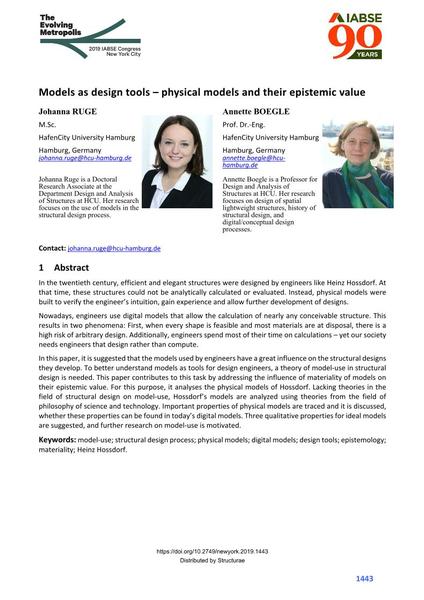Models as design tools – physical models and their epistemic value

|
|
|||||||||||
Bibliographic Details
| Author(s): |
Johanna Ruge
(HafenCity University Hamburg)
Annette Bögle (HafenCity University Hamburg) |
||||
|---|---|---|---|---|---|
| Medium: | conference paper | ||||
| Language(s): | English | ||||
| Conference: | IABSE Congress: The Evolving Metropolis, New York, NY, USA, 4-6 September 2019 | ||||
| Published in: | The Evolving Metropolis | ||||
|
|||||
| Page(s): | 1443-1448 | ||||
| Total no. of pages: | 6 | ||||
| DOI: | 10.2749/newyork.2019.1443 | ||||
| Abstract: |
In the twentieth century, efficient and elegant structures were designed by engineers like Heinz Hossdorf. At that time, these structures could not be analytically calculated or evaluated. Instead, physical models were built to verify the engineer’s intuition, gain experience and allow further development of designs. Nowadays, engineers use digital models that allow the calculation of nearly any conceivable structure. This results in two phenomena: First, when every shape is feasible and most materials are at disposal, there is a high risk of arbitrary design. Additionally, engineers spend most of their time on calculations – yet our society needs engineers that design rather than compute. In this paper, it is suggested that the models used by engineers have a great influence on the structural designs they develop. To better understand models as tools for design engineers, a theory of model-use in structural design is needed. This paper contributes to this task by addressing the influence of materiality of models on their epistemic value. For this purpose, it analyses the physical models of Hossdorf. Lacking theories in the field of structural design on model-use, Hossdorf’s models are analyzed using theories from the field of philosophy of science and technology. Important properties of physical models are traced and it is discussed, whether these properties can be found in today’s digital models. Three qualitative properties for ideal models are suggested, and further research on model-use is motivated. |
||||
| Keywords: |
physical models design tools model-use structural design process digital models epistemology materiality Heinz Hossdorf
|
||||
